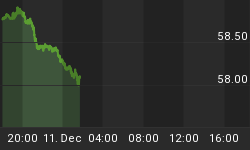In part 1 of this series, I put forth the notion that extreme data points, like investor sentiment, don't always result in a reversion to the mean, but may in fact represent the start of a new trend. Today, I will tear apart the sentiment indicators even more putting their value into question.
In some respects, investor sentiment is only good if the prevailing opinions of investors is at odds with the current price action. If prices head lower, we would expect investors to turn bearish, and if prices head higher, investors become euphoric. Now the bullishness or bearishness may be unfounded, but for the most part investor sentiment tracks the ascent and rise of prices. Although noteworthy, it is the rare situation where investor sentiment actually deviates from the rise or fall in prices. This can be seen in the following two examples.
Example 1 shows the "Dumb Money" indicator. This is the same "Dumb Money" indicator I show every week in our weekly wrap up on investor sentiment. Overlaying the "Dumb Money" indicator (in black) is a slow stochastic oscillator, which is a measure of the price action, and as you can see, the stochastic pretty much tracks the "Dumb Money" indicator. For the most part, the stochastics becomes oversold just as investors become bearish (i.e., bull signal).
Figure 1. "Dumb Money"/ weekly
Example 2 shows a daily chart of the S&P500, and the red line over the chart is the MarketVane bullish percent. This is another example where the sentiment indicator tracks the price action very nicely.
Figure 2. S&P500 v. MarketVane/ daily
So the question I would ask: where is the value in tracking investor sentiment?
From these examples, it appears that measures of investor sentiment are only a reflection of price movements. Furthermore, it is the rare situation where price and sentiment actually deviate. In many respects and as I have presented it here, there is very little value in tracking investor sentiment as you can derive the same information by following price.
So back to our question above: where is the value in tracking investor sentiment?
As we know, investor sentiment comes in several flavors. We have the "dumb money" and "smart money" and company insiders. Wouldn't it be nice to know what the "smart money" is doing while prices are dropping? And as I will show in a future installment, extremes in investor sentiment do matter even if they don't always predict the direction of prices.
















